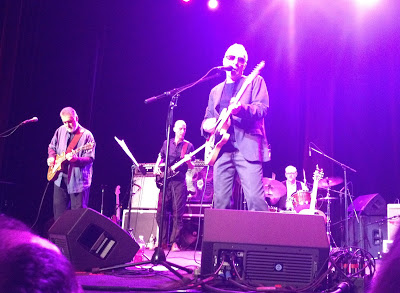Graham Parker and The Rumour at the Wilbur Theatre in Boston, Mass. 12/6/12
Saw a terrific Graham Parker and The Rumor gig at the Wilbur Theatre last night. I've seen G.P. a dozen or so times since the mid ’80s, but I don’t recall ever seeing him so positively agitated. Playing all his early hits, not to mention his latest stellar release (Three Chords Good), with the original musicians who helped him mint them seems to have lit a fire under the old sardonic Brit.
An added bonus was a great opening set by G.P. sometime accompaniests and wonderful band in their own right, The Figgs. Our front row seats didn’t hurt either.
Being that close, made for an interesting sonic perspective. We caught more of the sound out of the band members’ individual amplifiers (hearing Martin Belmont’s delightfully clean and crisp vintage Strat tone the loudest since his amp was 10 feet directly in front of us). We caught a bit of bleed of the mixed sound out of the back of the stage monitors, as well as from the house PA sound that filled the space behind us in the small theater. Fortunately, Graham’s voice cut through loud and clear, but it did make for a bit of a different effect than one is accustomed to hearing.
The new and old tunes fit seamlessly, with standout new tracks being the new “Coathangers” (which Graham noted had “stirred up a bit of controversy ... never a bad thing”) and “A Lie Gets Halfway ’Round the World” nearly matching the most inspired classics: “Protection,” “Get Started (Don’t Start a Fire),” “Stupefaction,” “Passion Is No Ordinary Word” and “Don’t Ask Me Questions.”
I won’t be surprised to see an official live recording of this 2012 reunion tour before too long. I know I’d buy it. Despite their encroaching geezer-dom, G.P. and the guys proved without a doubt that, indeed, “Passion Is No Ordinary Word” when it comes to their music.
Here’s looking at you, Graham!
SET LIST:
The Wilbur Theatre, Boston, Mass.
Thursday, Dec. 6, 2012
• Fool’s Gold
• Never Gonna Pull It Apart
• Hotel Chambermaid
• Coathangers
• Get Started (Start a Fire)
• Old Soul
• Stop Cryin’About the Rain
• Long Emotional Ride
• Live in Shadows
• A Lie Gets Halfway ’Round the World
• Watch the Moon Come Down
• Discovering Japan
• Nobody Hurts You
• Protection
• Stupefaction
• Local Girls
Encores:
• That Moon Was Low
• Passion Is No Ordinary Word
• Don’t Ask Me Questions
• Soul Shoes (with The Figgs joining in)















